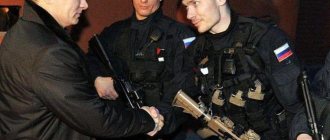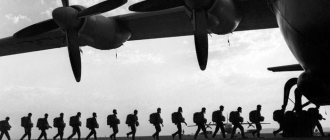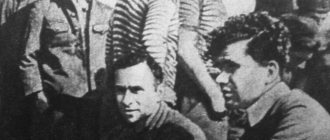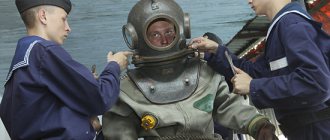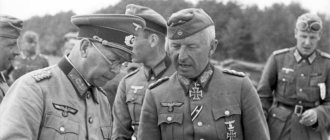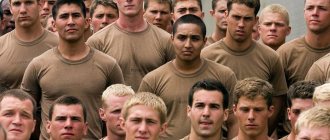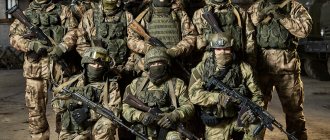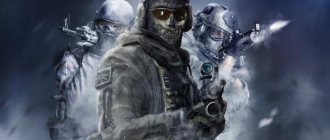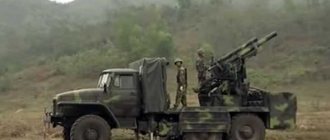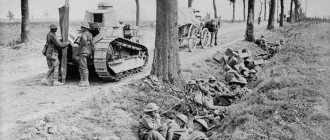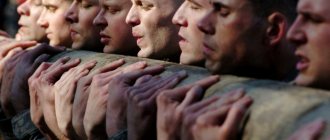05.06.2013
Today, 15 army special forces units are subordinate to the GRU of the General Staff of the Russian Federation, including the 22nd separate special forces brigade, formed in 1976. It should immediately be noted that the 22 OBRSpN is a unique military formation within the Russian Army; it is the only unit awarded the title “Guards” after the Great Patriotic War. We remind you that the most distinguished units of the Red Army during the Second World War, those who showed massive heroism, became guardsmen - the only case with post-war enrollment in the ranks of the 22nd OBRSpN guard.
Of course, the Voentpro online store could not ignore 22 OBRSpN - the pride and most powerful striking force of the Russian army. We present to your attention the personalized flag of the 22nd Special Forces Brigade. The flag of the special forces of the 22nd Guards ObrSpN GRU combines the symbols of the airborne troops and military intelligence - from the very creation of the 22nd Special Forces Brigade, parachute training was carried out here, and the uniform of the special forces of the 22nd Special Forces Brigade was Airborne. A scout bat and an inscription with the name of the unit have been added to the traditional Airborne Forces flag. You can buy a special forces flag of the Airborne Forces of the 22nd Guards ObrSpN GRU today in the Voentorg Voenpro online store. Our Voentorg produces such personalized flags to order, you can choose any suitable size. This article is dedicated to the history and present of the special forces unit from Rostov-on-Don; we, if possible, will try to talk about the most important historical milestones, the heroes who made the history of the 22nd OBRSpN.
Stationed today in the Rostov region, the 22nd Guards Special Purpose Brigade was formed as part of the Central Asian Military District in the Kazakh city of Kapchagai. A new military district was also created in 1976 by dividing into Turkestan and, in fact, Central Asia. The 15th GRU Special Forces Brigade was transferred to the jurisdiction of the TurkVO; it was necessary to create a new special forces unit. Over the 14 years that have passed since the formation of the Special Forces troops, such formations have proven themselves so well that the need to have at least one special forces brigade as part of the military district was undeniable. The wide range and degree of complexity of the tasks performed by the GRU special forces made the corresponding units the necessary army elite. Voentorg "Voenpro" reminds you that in our store a whole section is dedicated to the GRU Special Forces troops, for example, you can buy a special forces flag with the famous bat.
The formation of brigade number 22 of the GRU Special Forces was completed by July 24, 1976 - today Fr. The location of the 22nd special forces brigade was chosen to be a military town that had previously housed an anti-aircraft missile unit; the arrangement of the unit was entrusted to the shoulders of the first brigade commander I.K. Frost. To form the unit, a special forces detachment was allocated from the 15th Special Forces Brigade of the GRU General Staff and specialists in special radio communications; V.A. was responsible for preparing the replenishment. Warriors, whose contribution to the creation of 22 OBRSpN is difficult to overestimate. The well-known article by retired Colonel Boris Kerimbaev, “The Kapchagai Battalion,” describes the training of soldiers of the 22nd separate GRU special forces brigade at the initial stage. Among other things, he writes that in January 1980, the infrastructure of the unit was not sufficiently developed - the soldiers of the 22nd special forces brigade lived in tents, but even this was perceived as a plus: the only way to keep warm was incessant exercise. Parachute jumping was carried out in the unit from the very beginning, moreover, despite the fact that there was only one parachute company in the 22 Special Forces Brigade, absolutely everyone underwent training - it is no coincidence that the Airborne Forces symbols on the flag of the 22 Special Forces Brigade. The special forces brigade in Kapchagai quickly began to be perceived as one of the best in the district and the country.
Military intelligence units have always been the elite of the Russian armed forces. The formation of Soviet military intelligence after the October Revolution is primarily due to N.M. Potapov, it was under his leadership that after the October Revolution the system began to be restored and developed, which subsequently turned into the structure of the Intelligence Department, and then the GRU of the General Staff. Military intelligence is an integral part of the armed forces system, the importance of which is difficult to overestimate. Of course, our military store has created a special section where you can purchase a variety of goods with military intelligence symbols. The most valuable in the “Military Intelligence” section are, perhaps, the military intelligence flags. First of all, I would like to highlight the official flag of reconnaissance formations and military units. This banner is familiar to all military intelligence officers; the 22nd separate special forces brigade, which is discussed in this article, is no exception. Former or current military intelligence officers or those simply interested can buy this military intelligence flag in the Voentorg Voenpro online store today; all you need to do is go through a simple ordering procedure and wait for delivery.
The overthrow of the Amin regime in the Republic of Afghanistan in December 1979 was organized not only by local rebels, but primarily by special forces of the KGB of the USSR with the participation of 22 OBRSpN. The GRU army special forces detachment from Kapchagai was formed on a national basis and played a decisive role in the success of the operation - this became the impetus for the creation of 173 special forces in the Trans-Kazakhstan Military District (later part of the 22nd Guards Special Forces Brigade) and 177 special forces (as part of 22 ObrSpN) in the Central Asian military district in order to perform special tasks in the territories of Asian countries. At the initial stage of the war in Afghanistan, only the 177th “Muslim” detachment of the 22nd GRU special forces brigade took part in the fighting. The fighters of the “Kapchagay battalion” arrived in the DRA in October 1981 in complete secrecy, and by November 2 they found themselves at their place of deployment in the village of Meymene. Since 1982, 177 special forces of the GRU have been redeployed to the Panjer Gorge, from where shortly before this a large detachment of Ahmed Shah Masud was driven out; the latter swore on the Koran to recapture this territory within a month. For the Soviet command, holding on here was a matter of principle - only one special forces battalion (!!), 177 special forces, was allocated to solve the problem. Let us clarify that Massoud’s forces were driven out of the gorge by a 10,000-strong group of Soviet troops from the gorge with heavy fighting and huge losses - the “mad detachment” was sent to certain death. The Kapchagay battalion even exceeded its assigned task; the Panjera Gorge was under the flag of the 22nd OBRSpN for eight months instead of one. This cost the GRU special forces forty lives; the gorge was abandoned after the conclusion of another truce with Ahmed Shah Masud. The 177th OOSpN became the first unit to receive the battle banner on the territory of the DRA - this happened in 1983, at the same time the 177th detachment of the 22nd OBrSpN was awarded the Order for military merit. Later, the 177 Special Forces was renamed the Ghazni battalion and was one of the last to leave Afghanistan.
Military intelligence and special forces units of the GRU in Afghanistan have somewhat “non-core” tasks of protecting strategically important objects or storming enemy fortifications. Needless to say, soon Soviet military intelligence officers got used to the new mode of operation and terrified the enemy in absolutely any role. Truly, “Caution, intelligence” - this is exactly the warning you can see on the group of products of our military trade from the “military intelligence” section. In order to buy keychains, lighters, stickers, magnets, or this T-shirt with the inscription “Beware, Intelligence,” just follow the link and place an order in the standard way.
By 1985, the situation in Afghanistan had changed - it was decided to use military intelligence special forces on a larger scale. In April 1985, the headquarters of the 22 OBRSpN, headed by a commander, and three special forces detachments (173 ooSpN, 186 ooSpN, 370 ooSpN) were relocated to the territory of the DRA. Already in October, 411 ooSpN were formed, which also became part of 22 OBrSpN. In the photo below you can see soldiers of the 22nd separate special forces brigade (186 ooSpN) with the first captured Stingers. The 173rd OOSpN was stationed in Kandahar, and now the flag of the 22nd OOSpN was flying over the city of Farakhrud. As already mentioned, initially the 173rd special forces unit was not part of the 22nd special forces brigade; this officially happened only after the withdrawal of troops from Southern Afghanistan, which the 173th special forces unit was the last to leave.
The area of responsibility of the 22nd GRU special forces brigade became the southern part of Afghanistan, an area characterized by the greatest activity and training of mujahideen detachments. The headquarters of the 22nd OBRSpN was engaged in organizing reconnaissance, sabotage and other special operations, coordinating work with helicopter units. In 1987, the 295th separate helicopter squadron was transferred to the 22nd Special Forces Brigade, which also increased the efficiency of the 22nd GRU Special Forces Brigade. During the period of hostilities, the brigade bore the title of 2nd Omsbr (separate motorized rifle brigade) - the actions of special forces units in Afghanistan are still largely classified today. The successful operations of the 22nd GRU Special Operations Brigade are known to destroy caravans with weapons and fortified areas of the Mujahideen, to capture advisers from the USA, France, Germany, it has already been mentioned that the first captured Stingers were the merit of the special forces of the 22nd brigade. The capture of the Stinger MANPADS with documentation and a supply contract by the 22 OBRSpN is a separate story; this operation became proof of the participation of US forces in the war. In 1987, the 22nd GRU special forces brigade was awarded the pennant of the Minister of Defense “For Courage and Valor”; it is still kept on the territory of military unit 11659 and is used in holiday parades.
It is quite difficult to count how many awards the GRU special forces units received during the Afghan War, not only those who fought under the flag of the 22nd Special Forces Brigade, but also soldiers of friendly units. It is generally impossible to calculate the number of awards deserved but not received - in our country it has always been difficult with recognition, especially by contemporaries. One thing is obvious, special forces soldiers - yesterday, present or future - can be proud of having been or will be in the ranks of special forces. Our military engineer helps us not to forget about our military exploits and to be proud of our colleagues or simply compatriots, not only in wartime, but also in everyday life. Among the products in the “GRU special forces” section there are several types of T-shirts with the words Spetsnaz and corresponding symbols. Black or white GRU special forces T-shirts and tank tops are available in all sizes. Anyone can buy a special forces T-shirt, just follow the link and follow the instructions.
During the Afghan War, 3,196 soldiers of the 22nd Guards OBRSpN were awarded orders and medals, four were awarded the title “Hero of the Soviet Union.” Private Valery Arsenov received the Hero's Star posthumously - the grenade launcher of 173 ooSpN was seriously wounded during one of the combat missions, but continued to fire, and at a critical moment he covered the commander with his body and died on the spot.
On October 31, 1987, a legendary battle took place near the village of Duri, as a result of which three more servicemen of the 22nd special forces brigade were awarded the title of Hero of the USSR (two - posthumously). A reconnaissance group under the command of Oleg Onischuk, numbering 20 people with the call sign “Caspian”, moved to the site of the ambush on the Mujahideen caravan on October 28 and reached the place by the morning of the 30th. A convoy of three Mercedes full of weapons and ammunition was discovered and destroyed on the same day, but the group received orders to stay until the morning and wait for helicopters that would pick up the trophies and the soldiers of the 22 OBRSpN reconnaissance company. During the night, the militants concentrated several groups totaling about 200 people in the area of the ambush of Oleg Onishchuk’s group. Our main forces were supposed to arrive at 6 a.m., a few minutes before the appointed time, a group under the command of Lieutenant Onischuk moved towards the vehicles, leaving 11 people at the ambush site. The inspection group under the command of Oleg Onishchuk (5 people) moved towards the car; by 6 am there were no “turntables” in the sky, but “spirits” began to appear from everywhere. The scouts of the 22nd separate special forces brigade were fifty meters from the vehicles, when heavy fire from the bandits pinned them to the ground, it was decided to retreat to the cover group. The retreat of his comrades remained to be covered by the future hero of the Soviet Union, machine gunner Yuri Islamov (pictured below).
At that moment, the retreating four were attacked from the other flank; private 22 OBRSpN Igor Moskalenko opened fire from a machine gun and was soon killed by an enemy sniper. Meanwhile, Yuri Islamov ran out of ammunition, which, according to the testimony of his colleagues, caused a joyful cry from the attacking Mujahideen, who could not overcome the resistance of one person. However, the machine gunner still had grenades that flew towards the militants. When the soldier of the 22nd special forces brigade fell silent, opponents moved towards him with the goal of finishing off the Soviet special forces soldier who had so annoyed them, but Yuri Islamov was still alive, and he had one grenade left, with which he blew himself up and several approaching militants. The covering group of four people was also destroyed, senior lieutenant Oleg Onischuk, having shot all his ammunition, stood up to his full height, with a grenade and a knife in his hand, moved towards the advancing Mujahideen and took the last stand.
In order to destroy the remaining fighters of the 22nd OBRSpN, who were at the height, the bandits changed into the uniform of Soviet special forces, but the remaining fighters managed to repel another 12 attacks by the Mujahideen, killing two more soldiers of the 22nd special forces brigade. Reinforcements led by captain Yaroslav Goroshko arrived at 6:50. Here is what the commander of the 186 ooSpN company of the 22nd separate GRU special forces brigade himself writes about this: “My group and I were running around the take-off at 5:30, hoping to find the launching helicopters. Then they rushed to wake up the pilots. It turns out that the command was not given to them. While they found Egorov, while they contacted Air Force headquarters and received permission to take off, while the helicopters were warming up, the time for departure had long passed. The combat MIs took off only at 6:40. And the evacuation MIs - 8 at 7:20. When my group landed, we rushed to look for Onischuk’s guys. They lay on the mountainside, a chain stretching from the Mercedes to the top. Oleg Onishchuk lay tortured, stabbed with bayonets, clutching a knife in his hand. They violated him, stuffing his mouth with a piece of his own bloody body. These bastards did the same thing to privates Misha Khrolenko and Oleg Ivanov.”
The group under the command of Captain Yaroslav Goroshko, also awarded the Hero Star, destroyed 18 militants, putting the rest to flight - by that time only 8 soldiers of the 22nd separate GRU special forces brigade remained alive.
Even today you can hear different opinions about the death of Oleg Onishchuk’s group - they talk about a tragic coincidence of circumstances, the negligence of the authorities, and the excessive self-confidence of the scouts on the spot. One thing is indisputable: 12 scouts of the 22 OBRSpN died a brave death on the autumn morning of October 31, 1978. Here are the names of the heroes: Tair Jafarov, Oleg Ivanov, Yuri Islamov, Igor Moskalenko, Yashar Muradov, Marat Muradyan, Erkin Salahiev, Roman Sidorenko, Alexander Furman, Mikhail Khrolenko, Oleg Onischuk. Thanks also to these people, the flag of the 22nd Guards OBRSpN today is a banner that no one is ashamed to emulate.
The GRU special forces as a whole, not only the guys under the flag of the 22nd OBRSpN, played the most significant role in the Afghan war, starting with the legendary operation to storm the palace and eliminate Amin. During the war, it was the special forces units of the Main Intelligence Directorate of the General Staff who were entrusted with carrying out the most important and complex, sometimes practically impossible tasks. GRU special forces units began to form only in the 50s of the twentieth century, in the shortest possible time becoming the elite, the most combat-ready part of the regular army. And today the GRU Special Forces are the pride of the Russian armed forces; GRU special forces brigades have been at the forefront of any military conflict for more than 60 years. The section of the Voentorg online store “GRU Special Forces” is entirely dedicated to the Special Forces troops. Here you can find special forces flags, souvenirs and clothing with the symbols of the Russian army special forces. We remind you that GRU Special Forces Day is celebrated on October 24 of each year; in the corresponding section of our military store you will find a lot of souvenirs and serious gifts for friends or relatives related to special forces. If you yourself once served or are currently serving in a special forces brigade or simply have a relationship with the department, then among the products in the “GRU Special Forces” section you will certainly find a lot of interesting things, for example, right now you can buy this “Special Forces” sweatshirt with a hood.
The turn of the 80-90s of the last century was marked for the 22nd separate GRU special forces brigade by participation in endless interethnic conflicts on the territory of the USSR and abroad. In 1989, formations of the 22nd OBRSpN were sent to Angola, where the tasks of the Soviet special forces included instructing allies, guarding Soviet facilities and intelligence activities. In Baku in 1988-1989, the 173 Special Forces Special Forces were responsible for the security of areas with an Armenian population, in addition, special forces soldiers carried out tasks to disarm gangs in the region. Then there was a conflict in Nagorno-Karabakh - 173 and 411 special forces were responsible for the situation on the Armenian-Azerbaijani border; of the most famous operations of the fighters of the 22 special forces, we can recall here the destruction of a hail battery on the territory of Armenia, which shelled populated areas of Azerbaijan. Despite the fact that the special forces of the 22 OBRSpN acted on the side of the Azerbaijan Popular Front, immediately after the collapse of the USSR, attacks began on the military camp in which the forces of the 22 separate GRU special forces brigade were stationed. Soldiers and officers of the GRU army special forces were forced to once again demonstrate total superiority over the separatists.
“Total superiority” is perhaps the most accurate definition to characterize the actions of the Soviet and Russian GRU special forces in a wide variety of wars. The products of our military store will help you identify your belonging to your native branch of the military. In the GRU special forces section there is also a place for unique mugs with special forces symbols - such a souvenir will not only be a pleasant gift, but also a thing used every day. You can buy a “GRU Spetsnaz” mug right now, just go to the appropriate page.
Let's return to the story about the flag of the 22nd Special Forces Brigade. Soon a new problem arose - the armed forces of Azerbaijan did not want to release 22 OBRSpN from their territory with weapons, the question arose of disbanding the special forces brigade and transferring weapons to the Azerbaijani side. However, the issue was resolved in favor of the military - the 22nd separate brigade of the GRU Special Forces was transferred to the department of the North Caucasus Military District and since 1992 redeployed to the Rostov region.
A new chapter has begun in the history of one of the best units of the now Russian special forces. At the new location, the formations of the 22nd Guards ObrSpN had to once again set up “from scratch”, and the soldiers of the 173rd Special Forces were sent to the zone of the Ossetian-Ingush conflict two months later to carry out the next task. Almost immediately after returning from Ingushetia in 1994, the 173rd separate GRU special forces detachment was sent to Chechnya. The main burden of the First Chechen War fell on the shoulders of this particular unit of the 22nd separate GRU special forces brigade. Already in December 1994, soldiers of the 173rd special forces unit found themselves in Mozdok; even before the start of active fighting, the fighters of the 173rd special forces detachment carried out active reconnaissance operations, including preparing the assault on Grozny.
The motto of the GRU special forces has always been the phrase “Only the stars are above us,” perhaps somewhat arrogantly, but the local soldiers have the right to this. The exceptional level of training in the Special Forces troops allows them to solve exceptional problems. This motto, as well as the bat, are the main symbols of the Russian special intelligence forces. The famous bat can also be seen on the flag of the 22nd separate special forces brigade. In the “GRU Spetsnaz” section of our Voentorg you can buy various souvenirs with special forces symbols - here are the traditional bat, the Spetsnaz motto, blue and black colors, images of special forces soldiers on a mission. In order to buy car stickers, key chains, Zippo lighters, mugs or even a scarf with the symbols of the GRU special forces, just open the page with the product and place an order, delivery will be as fast as possible.
Among the operations of the Rostov special forces during the “First Chechen War”, the most famous is the participation of a detachment under the command of the hero of Russia, Major V. Nedobezhkin from the 173rd special forces unit in the operation to encircle S. Raduev’s gang in the village of Pervomaiskoye. A large group of militants (about 200 people) broke through the encirclement and moved towards the combined detachment of 173 special forces - the attack was repulsed, 45 special forces killed 85 mercenaries, more than during the entire period of the assault on the village with all forces. Thus, the fighters of the 22nd Guards ObrSpN once again confirmed the status of one of the most combat-ready units of the Russian army. Based on the results of that battle, the stars of Heroes of Russia were given to: Major Vladimir Nedobezhkin, Captain Valery Skorokhodov, Senior Lieutenant Stanislav Kharin, Lieutenant Albert Zaripov and Captain Sergei Kosachev (posthumously). Albert Zaripov, today a famous writer and human rights activist, wrote the book “May Day” about those events. Hero of Russia Sergei Kosachev, a medical officer of the 22nd separate special forces brigade, was killed by militants while carrying a wounded soldier from the battlefield. Soldiers of the 22nd ObrSpN GRU General Staff, as part of the 173rd special forces detachment, were on the territory of Chechnya until 1996, where they carried out many special operations to destroy the leaders of gangs, encircle and destroy large enemy groups.
The special forces of military intelligence have once again demonstrated “total superiority,” but we remind you that among the products of the Voentorg online store “Voenpro” in the “Military Intelligence” section today there are not only a lot of different thematic souvenirs, but also casual clothing for people with attitude towards service in the GRU units of the General Staff. You can buy T-shirts, tank tops, sweatshirts or shorts with military intelligence symbols.
The second Chechen campaign for the 22nd GRU special forces brigade from Rostov also started long before the start of the war. This time, the first unit under the flag of the 22nd Guards OBRSpN to the area of tension in 1998 was the 411th special forces detachment that left Kaspiysk; three months later, 173 OOSpN replaced their comrades on the border of Dagestan and Chechnya - that’s how they changed. Since the beginning of hostilities, a combined detachment of the 22 OBRSpN, the basis of which was made up of military personnel of the 411 Special Special Forces, operated here. Soldiers of the 22nd Guards Separate Special Forces Brigade remained on the territory of Chechnya even after the end of hostilities. The command has repeatedly recognized the combined detachment of the 22nd Special Forces Brigade as the most effective unit of the group of troops in the North Caucasus. During the Second Chechen War, two soldiers of the 22nd Guards OBRSpN were awarded the title “Hero of Russia”. In August 1999, a reconnaissance detachment of the 22nd special forces brigade carried out an operation to free an Interior Ministry officer from captivity, when it already seemed that the task had been completed, the special forces were overtaken by a detachment of militants and surrounded. Soldiers of the 22nd OBRSpN took refuge in an abandoned building and successfully repelled several enemy attacks, but they were running low on ammunition. All that remained was to fight our way out of the encirclement. Sergeant Dmitry Nikishin was the first to leave the shelter and covered the retreat of his colleagues with machine gun fire. During the retreat, the detachment commander was seriously wounded, Sergeant Nikishin carried him to the shelter, but by that time the Rostov special forces officer had died from his wounds. For his heroism, courage and combat training (several militants were destroyed by fire from the sergeant of the 22nd ObrSpN), Dmitry Nikishin was awarded the title of Hero of Russia.
The commander of the reconnaissance group of the combined detachment of the 22nd separate brigade of the Special Forces of the GRU, Vyacheslav Matvienko, was awarded the title of Hero of Russia posthumously. While carrying out a reconnaissance operation to identify the positions of bandits, a military intelligence special forces group under the command of Vyacheslav Matvienko found itself on the verge of encirclement. The fighters of the 22nd ObrSpN GRU once again confirmed their highest class, throwing back superior enemy forces and retreating to a safe distance. The success of the Rostov special forces group in battle was largely due to the clear and thoughtful instructions of the commander. There were wounded on the battlefield, whom Vyacheslav Matvienko personally carried to a safe zone. The fourth sortie became fatal - a sniper’s bullet ended the life of a senior lieutenant of the 22nd special forces brigade.
We remember and honor the names of all the heroes of all wars, we try to highlight the most memorable milestones as much as possible - all this is important to know in order, firstly, not to repeat the mistakes of the past, and secondly, to know who is worth emulating. The products of our military trade are also a way to express gratitude to the people thanks to whom our state is still sovereign and indivisible. Among the thematic flags of the GRU special forces and foreign intelligence we offer, there are a variety of banners: these are personalized flags of units, such as the flag of 22 OBRSpN, and standard flags of military branches, and those made outside of any standards, but this does not lose value. The latter includes the military intelligence flag, which you can see below - it depicts a GRU special forces soldier in the process of performing a combat mission, who is covered by “turntables”. In order to buy any of the flags dedicated to intelligence officers and special forces, visit the corresponding section.
In April 2001, the military intelligence special forces unit, which had already become legendary, received the well-deserved name “Gvardeiskaya”. We remind you that the 22nd Guards Separate Special Forces Brigade is the first and only unit in the domestic armed forces to receive this rank after World War II. The main impetus for this decision was the results of the First and Second Chechen campaigns - the 22nd OBRSpN was recognized by the command as the absolutely best military unit of this period.
Today, units of the 22nd Guards ObrSpN are deployed in the vicinity of the city of Aksai, Rostov region (Stepnoy village) and the village of Bataysk (108 and 173 oSpN). 108 ooSpN is the youngest unit of the Russian military intelligence special forces, but already in 2004 it was recognized as the best in terms of training. The basis of the combined detachment of the 22nd special forces brigade in South Ossetia in 2008 was also 108 special forces. Also directly subordinate to the GRU special forces brigade in Aksai is 56 special forces.
It is not for nothing that the military personnel of the 22nd Guards Separate GRU Special Forces Brigade are considered the best personnel of the domestic armed forces; service in the Rostov Special Forces involves endless training, marching, shooting and parachute jumping. In addition, although this military intelligence special forces unit is not considered a mountain unit, training in high altitude conditions is also carried out. It is pointless to write in detail about how the soldiers fighting under the flag of the 22nd OBRSpN are trained - and much is simply classified; it is enough to know how these guys perform in real combat.
Today, the 22nd Guards ObrSpN is primarily supplied with modern equipment and machinery, for example, the Rostov special forces are armed with the Tiger combat vehicle from the Gorky Automobile Plant. Or this drone “Pear”, used by fighters of the 22nd ObrSpN GRU since 2009.
At the end of the story about the 22 OBRSpN and its flag, I would like to present this video, where you can see the everyday life and holidays of the 22 GRU special forces brigade. On the Internet you can also find a lot of thematic videos showing demonstration performances, exercises and training of fighters of the 22nd ObrSpN - an impressive spectacle. The song playing in the background in the video below is the official anthem of the unit; even in the matter of self-identification, the 22nd Special Forces Brigade is ahead of its competitors. We remind you that you can purchase another symbol of the brigade today in our military store - the procedure for ordering the flag 22 ObRSpN is standard.
Well, our military trader reminds you that July 24 - day 22 of the OBRSpN is just around the corner, and if you or someone close to you serves or served in the Rostov special forces, then the flag of the 22nd Guards Special Purpose Brigade will certainly be the best gift on this day. However, souvenirs with the symbols of the GRU special forces, for example, a cover for a military ID, will also undoubtedly be a pleasant surprise. Well, since we’re talking about gifts, we suggest you pay attention to this towel with the symbol of the Airborne Forces, which recently expanded the range of the Voentpro military store.
← Marine units of the border troops Gifts for Airborne Forces Day 2022 →
Training for special forces
The GRU special forces training system is the stuff of legends. Methods of training special forces soldiers:
- Classes in classes, a physical training camp, at the shooting range, on the “scout trail”.
- Studying methods of survival, camouflage techniques, practicing tactical actions “in the field”, in a training camp.
- Consolidation and development of skills in competitions.
Book by S. Balenko “Survival Manual for GRU Special Forces. Experience of elite units" has become a reference manual for many fighters. In the book, GRU veterans share their experience of surviving in extreme conditions.
Number of divisions
GRU statistics have only estimated data on the number of employees of the department and its structure.
According to the order of the USSR Minister of Defense dated April 23, 1953 No. 0037, the department consisted of 896 people. Staff of the central apparatus of the 2nd Directorate of the General Staff by structural units:
However, the number of department employees has changed over time. Today, GRU statistics range from 6 to 15 thousand people. The department also includes 25 thousand military personnel who serve under contract.
Intelligence Directorate Structure
In 1992, the department was headed by E. Timokhin. However, I. Serguna (2011–2016) is considered the most significant figure. Intelligence operations of the last decade (Crimea, Syria) took place during his leadership.
Until the end of 2022, the department was headed by Colonel General I. Korobov. However, he died from a long illness. The candidate for the post of head of the GRU is Vice Admiral I. Kostyukov.
There are no official references to the structure of the intelligence department online. According to unconfirmed data, the GRU structure has 21 divisions. The department includes a sabotage and intelligence service and military formations.
Main structural divisions of the department:
- EU countries (1 directorate).
- America, Australia, Great Britain, New Zealand (2 division).
- Asia (3rd department).
- Africa (4th division).
- Operational intelligence (5th department).
- OsNaz (radio engineering, 6th department).
- NATO.
- Special Forces (sabotage department).
- War economy.
- Military technologies.
- Information Warfare Department.
- Strategic management.
- Space reconnaissance.
Auxiliary departments - external relations, operational and technical, administrative, personnel and archives. The department also has an information service and a special security department.
GRU brigades operate in the North Caucasus, Far East, Southern, Central and Western Military District.
The departments are managed by the mobilization center from the headquarters on the street. Grizodubova in Moscow. Previously, the GRU headquarters was located on Khoroshevskoye Highway.
Lay low in Barnaul
The next time, on June 8, 2006, Dmitry came on a date to the pre-trial detention center in almost the same clothes that his older brother was wearing: they were distinguished only by a cap and glasses. Vob quietly took his brother’s exit pass and his passport, and then calmly left under the guise of a visitor.
And Dmitry was taken to the room where, after visits, the prisoners await a convoy to be sent to their cells. Only at this time the guards noticed the substitution. No more than 15 minutes passed after Wob left pre-trial detention center No. 1, but they could not catch him.
According to some sources, his wife was waiting for him in a car; according to others, he simply caught a taxi. But everything turned out to be even simpler: Vob took a regular bus and went to his wife, and then both disappeared.
After this escape, the cafe in the detention center was closed and security measures were tightened. You can’t just get a pass there anymore
About ten people from the shift that Wob escaped to were fired. The fugitive himself, along with his wife Elena, was found in the center of Barnaul a few weeks after the trick with the brothers - they rented an apartment on the outskirts of the city and wanted to hide.
Voblikov already had a good quality fake passport with him - there is information that his gang was involved in the attack on the police department, from where about 40 passport forms disappeared. Probably one of the forms was used by the fugitive. On the day of the arrest, the couple was being escorted by operatives from the very morning.
The surveillance was so tight that several police officers got on the same tram with Wob and his wife, and several more were traveling behind the tram in a car.
At some point, the tram stopped urgently, the former special forces soldier rushed into the park like lightning, but they managed to knock him to the ground and twist him
The operatives feared that Voblikov would not hesitate to use a weapon as “a very freedom-loving and dangerous criminal” (the definition of the police), but everything went smoothly, and he was sent back to pre-trial detention center No. 1 to await trial.
History of creation
The history of the GRU begins in 1918. The department was finally formed at the beginning of 1950. Limited information is available to the public about the activities of the intelligence services of those times. After the collapse of the USSR, some data was disclosed.
By 2010, military reform was gaining momentum. The intelligence department became known as the GRU of the General Staff of the Russian Armed Forces. However, the former name of the special service is considered more familiar to society. The department has its own portal – https://structure.mil.ru. The GRU website provides information about what the department does, what tasks it sets for itself, who serves in the intelligence department, and how to become a special forces soldier. The website provides a feedback form and contact numbers.
The Russian GRU is not just foreign intelligence. The department is an independent structure that manages other military organizations. Coordination of subordinate departments is carried out exclusively in the interests of the state. The head of the GRU reports to the chief of the general staff and the minister of defense.
At all times, the department ensured the security of the state. During the Cold War, intelligence operatives tracked the location of nuclear weapons and the changing arsenal of defensive and offensive weapons at NATO bases. New land- and sea-based weapons carriers were deployed by the States almost weekly
The GRU had to regularly monitor hot spots on the planet. Tracking satellites were not the only source of information. A flotilla of reconnaissance ships also made their contribution. GRU officers intercept information primarily using electronic and radio means. What is the difference between the KGB (later FSB) and the GRU? Differences between departments:
- KGB - counterintelligence, identification of dissidents, operational search work, protection of party leaders.
- GRU – foreign intelligence (space, military, industrial).
Both departments interacted with each other. The proof was the monthly working meetings between the head of the GRU and the head of the KGB. They began to be held in 1963.
Brotherly escape
Pre-trial detention center No. 1 in Novosibirsk is the oldest institution of the Federal Penitentiary Service (Federal Penitentiary Service) within the city. Wob ended up there in 2006 while investigators, one after another, found new episodes in his criminal biography. And it was Voblikov who became the first who managed to escape from this detention center.
One of the features of the pre-trial detention center was that relatives of the prisoners came to meet them in the cafe at the detention center. It was always crowded there: prisoners were brought out in groups to their relatives or lawyers. First, the prisoners were transferred from their cells to a special room, and from there they were taken to a cafe.
And Voblikov noticed that although all entrances and exits to the cafe were kept under guard, under certain conditions it was possible to get lost there
In freedom, Vob's closest assistants include his wife Elena and his brother Dmitry, who is only a year younger and very similar to him.
Pre-trial detention center No. 1 in Novosibirsk
Photo: Fsin-mag.ru
Investigators familiar with Voblikov mentioned that he is a very powerful person and a good manipulator. But his brother, on the contrary, is weak-willed and driven. Wob told his wife that he couldn’t sit anymore - he’d rather commit suicide. But he put pressure on his brother differently: he promised a lot of money and a good lawyer.
Both Elena and Dmitry agreed to carry out Voblikov's plan. To begin with, Elena found a form from the Novosibirsk Regional Court and found out where to make a fake stamp of good quality.
On this form she entered Dmitry Voblikov as the civil defender of his convicted brother
The judge’s signature on this form was forged by Valery himself at one of the dates. Then, with this “document,” Dmitry once went for reconnaissance in pre-trial detention center No. 1: the paper did not raise any doubts among the detention center employees. Then, on a date, the brothers discussed the final stage of the plan.
